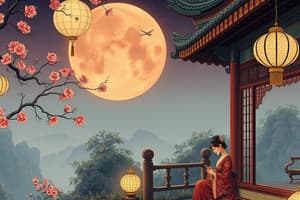Podcast
Questions and Answers
What was a significant achievement of the military modernization efforts in Japan?
What was a significant achievement of the military modernization efforts in Japan?
- Foundation for building a strong army (correct)
- Establishment of a modern educational system
- Implementation of an electoral system
- Introduction of a fair trial system
Which reform marked the first time elections were conducted in Chinese history?
Which reform marked the first time elections were conducted in Chinese history?
- Setting up national assemblies (correct)
- Abolition of the civil service examination
- Establishment of the Supreme Court
- Encouragement of entrepreneurs
What was a primary goal of the modernized legal system established during this period?
What was a primary goal of the modernized legal system established during this period?
- To ensure fair and just trials (correct)
- To promote military techniques
- To increase student enrollment in schools
- To establish a strong economy
What educational reform significantly impacted independent thinking in China?
What educational reform significantly impacted independent thinking in China?
What was the impact of sending a large number of Chinese students abroad?
What was the impact of sending a large number of Chinese students abroad?
What approach was taken to encourage economic modernization during this time?
What approach was taken to encourage economic modernization during this time?
Which social reform was implemented to enhance the quality of life for the people?
Which social reform was implemented to enhance the quality of life for the people?
What was a key result of the establishment of universities across the nation?
What was a key result of the establishment of universities across the nation?
What was one of the primary outcomes of the boycott of Japanese goods during the MFM?
What was one of the primary outcomes of the boycott of Japanese goods during the MFM?
Which of the following intellectuals is NOT mentioned as a critic of traditional ethics?
Which of the following intellectuals is NOT mentioned as a critic of traditional ethics?
What concept did Hu Shi primarily promote in relation to literature during the MFM?
What concept did Hu Shi primarily promote in relation to literature during the MFM?
How did the MFM impact gender equality and education in China?
How did the MFM impact gender equality and education in China?
Which of the following statements accurately reflects the view of intellectuals during the MFM?
Which of the following statements accurately reflects the view of intellectuals during the MFM?
Which of the following changes in education occurred as a result of the MFM?
Which of the following changes in education occurred as a result of the MFM?
What was one of the impacts of the New Cultural Movement on Chinese nationalism?
What was one of the impacts of the New Cultural Movement on Chinese nationalism?
Which factor contributed to the growth of national industries in China during the MFM?
Which factor contributed to the growth of national industries in China during the MFM?
What significant political change occurred as a result of the 1911 Revolution?
What significant political change occurred as a result of the 1911 Revolution?
What did Yuan Shikai promise in exchange for support from Sun?
What did Yuan Shikai promise in exchange for support from Sun?
Which of the following was a cultural change attributed to the 1911 Revolution?
Which of the following was a cultural change attributed to the 1911 Revolution?
What did Yuan Shikai do on 12 February 1912?
What did Yuan Shikai do on 12 February 1912?
What was one result of the new education laws passed by the provisional government?
What was one result of the new education laws passed by the provisional government?
What lifestyle transformation was promoted by the 1911 Revolution?
What lifestyle transformation was promoted by the 1911 Revolution?
What political system was adopted in China as a result of the 1911 Revolution?
What political system was adopted in China as a result of the 1911 Revolution?
Which event marked the establishment of the Beiyang government?
Which event marked the establishment of the Beiyang government?
What did Hu Shi believe was necessary for China's modernization?
What did Hu Shi believe was necessary for China's modernization?
Which principle did NOT seem to be acknowledged as beneficial towards modernization according to intellectuals?
Which principle did NOT seem to be acknowledged as beneficial towards modernization according to intellectuals?
Which of the following best describes the situation after the military rule in Nanjing?
Which of the following best describes the situation after the military rule in Nanjing?
What aspect of governance was emphasized during the Nanjing reforms?
What aspect of governance was emphasized during the Nanjing reforms?
What was the North Expedition primarily focused on?
What was the North Expedition primarily focused on?
What was one of Sun Yat-sen's contributions towards governance during the Nanjing reforms?
What was one of Sun Yat-sen's contributions towards governance during the Nanjing reforms?
According to Li Yunhan, what was one consequence of the ideological vacuum left by MFM?
According to Li Yunhan, what was one consequence of the ideological vacuum left by MFM?
Which of the following was NOT a governing strategy implemented during the Nanjing reforms?
Which of the following was NOT a governing strategy implemented during the Nanjing reforms?
What was a significant limitation of the 1911 Revolution in China?
What was a significant limitation of the 1911 Revolution in China?
Which event demonstrated Yuan's autocratic governance?
Which event demonstrated Yuan's autocratic governance?
What was a primary reason for the failure to modernize society after the 1911 Revolution?
What was a primary reason for the failure to modernize society after the 1911 Revolution?
What major goal did Sun Yat-sen have that could not be fulfilled after the revolution?
What major goal did Sun Yat-sen have that could not be fulfilled after the revolution?
What indicates that traditional thoughts still influenced the population post-revolution?
What indicates that traditional thoughts still influenced the population post-revolution?
The socio-economic situation after the 1911 Revolution can be summarized by which statement?
The socio-economic situation after the 1911 Revolution can be summarized by which statement?
What action did Yuan take in 1913 to weaken the Nationalist Party?
What action did Yuan take in 1913 to weaken the Nationalist Party?
Which factor contributed to the lack of political stability in China after the 1911 Revolution?
Which factor contributed to the lack of political stability in China after the 1911 Revolution?
What was established in 1926 as part of Jiang's Northern Expedition?
What was established in 1926 as part of Jiang's Northern Expedition?
Which Yuan was responsible for making laws during the Nanjing Government?
Which Yuan was responsible for making laws during the Nanjing Government?
What significant reform did the Nanjing government implement regarding the judicial system in 1932?
What significant reform did the Nanjing government implement regarding the judicial system in 1932?
Which of the following was NOT part of the Nanjing government’s cultural and social reforms?
Which of the following was NOT part of the Nanjing government’s cultural and social reforms?
What constitutional development occurred in 1931 under the Nanjing government?
What constitutional development occurred in 1931 under the Nanjing government?
By 1937, how many primary schools had been established as part of the educational reforms?
By 1937, how many primary schools had been established as part of the educational reforms?
What was the main reason for the limited governance of the Nanjing government?
What was the main reason for the limited governance of the Nanjing government?
Which Yuan was tasked with supervising government operations?
Which Yuan was tasked with supervising government operations?
Flashcards
Military Modernization
Military Modernization
The process of modernizing China's military by adopting Western practices, techniques, and equipment. This included sending military officers to Japan to learn modern tactics and establishing a system for training and developing a strong military force.
Modernized Legal System
Modernized Legal System
The establishment of a modern legal framework in China, including codified laws and a structured judicial system. This involved revising existing laws, establishing courts, and advocating for the principle of judicial independence.
Economic Modernization
Economic Modernization
The process of fostering economic growth and development in China through the introduction of modern industries, manufacturing, and commerce. This involved encouraging entrepreneurship, establishing new factories and mines, and promoting industrial innovation.
Enhancing Quality of People
Enhancing Quality of People
Signup and view all the flashcards
Modern Educational System
Modern Educational System
Signup and view all the flashcards
Political Modernization
Political Modernization
Signup and view all the flashcards
First Elections in Chinese History
First Elections in Chinese History
Signup and view all the flashcards
Western Thought Influencing Students
Western Thought Influencing Students
Signup and view all the flashcards
How did the May Fourth Movement contribute to economic development?
How did the May Fourth Movement contribute to economic development?
Signup and view all the flashcards
What were the main ideological changes brought about by the MFM?
What were the main ideological changes brought about by the MFM?
Signup and view all the flashcards
How did the MFM impact the development of Chinese literature?
How did the MFM impact the development of Chinese literature?
Signup and view all the flashcards
How did the MFM contribute to the rise of nationalism in China?
How did the MFM contribute to the rise of nationalism in China?
Signup and view all the flashcards
What were the MFM's key contributions to education and gender equality?
What were the MFM's key contributions to education and gender equality?
Signup and view all the flashcards
Why is the May Fourth Movement considered a turning point in Chinese history?
Why is the May Fourth Movement considered a turning point in Chinese history?
Signup and view all the flashcards
How did the May Fourth Movement contribute to national identity?
How did the May Fourth Movement contribute to national identity?
Signup and view all the flashcards
What was the impact of the MFM on China's political landscape?
What was the impact of the MFM on China's political landscape?
Signup and view all the flashcards
End of Dynastic Rule in China
End of Dynastic Rule in China
Signup and view all the flashcards
Yuan Shikai's Role in the Revolution
Yuan Shikai's Role in the Revolution
Signup and view all the flashcards
Establishment of the Republic of China
Establishment of the Republic of China
Signup and view all the flashcards
Modernization and Westernization
Modernization and Westernization
Signup and view all the flashcards
Transformation of Social Customs
Transformation of Social Customs
Signup and view all the flashcards
Education Reform for Women
Education Reform for Women
Signup and view all the flashcards
Political Modernization in China
Political Modernization in China
Signup and view all the flashcards
Transition from Feudal Society
Transition from Feudal Society
Signup and view all the flashcards
Post-Sun Yat-sen Era
Post-Sun Yat-sen Era
Signup and view all the flashcards
Northern Expedition
Northern Expedition
Signup and view all the flashcards
Establishment of the Nationalist Government
Establishment of the Nationalist Government
Signup and view all the flashcards
Five-Power Government
Five-Power Government
Signup and view all the flashcards
1936 Constitution
1936 Constitution
Signup and view all the flashcards
Judicial Reforms
Judicial Reforms
Signup and view all the flashcards
Promotion of Universal Education
Promotion of Universal Education
Signup and view all the flashcards
Limitations of the 1911 Revolution
Limitations of the 1911 Revolution
Signup and view all the flashcards
Yuan Shikai's Autocratic Rule
Yuan Shikai's Autocratic Rule
Signup and view all the flashcards
Influence of Confucianism
Influence of Confucianism
Signup and view all the flashcards
Low Literacy Rate
Low Literacy Rate
Signup and view all the flashcards
Rise of Warlords
Rise of Warlords
Signup and view all the flashcards
Economic Hardship
Economic Hardship
Signup and view all the flashcards
Impact of the 1911 Revolution
Impact of the 1911 Revolution
Signup and view all the flashcards
Land Reform Failure
Land Reform Failure
Signup and view all the flashcards
Rule of Law
Rule of Law
Signup and view all the flashcards
Complete Westernization
Complete Westernization
Signup and view all the flashcards
Scientific Solutionism
Scientific Solutionism
Signup and view all the flashcards
Refilling the Ideological Vacuum
Refilling the Ideological Vacuum
Signup and view all the flashcards
Military Rule (軍政)
Military Rule (軍政)
Signup and view all the flashcards
Political Tutelage (訓政)
Political Tutelage (訓政)
Signup and view all the flashcards
Three-Phase Revolution
Three-Phase Revolution
Signup and view all the flashcards
Study Notes
Early Attempts at Modernization - Late Qing Reform (1901-1911)
- Anti-foreign sentiment ran high in China after the Boxer Rebellion (1900), leading to demands for reform.
- The Boxer Protocol, a treaty signed in 1901, highlighted the need for strengthening China and modernizing.
- Regional governors, such as Li Hongzhang and Liu Kunyi, resisted imperial orders during the Boxer Rebellion, indicating a growing decentralization of power.
- Mutual protection pacts with foreign powers further showcased the political decentralization of the Qing Dynasty.
- The Qing government sought reforms to consolidate central power and address growing weaknesses.
- Modernization efforts included educational, economic, social, judicial, and military reforms.
- Educational reforms led to the establishment of modern schools and the abolition of the civil service examination.
- Economic reforms included setting up ministries, building railways, and creating a national budget.
- Social reforms addressed issues like intermarriage and foot-binding to encourage modernization.
- Military reforms established modern military academies and reformed military structure and equipment.
- A more extensive judicial system was created to address legal reforms, with new criminal and commercial codes.
- The failure of previous reform attempts, like the Self-Strengthening Movement and the Hundred Days Reform, led to skepticism and distrust in the Qing Dynasty’s approach to modernization.
Success of Meiji Modernization
- Japan's modernization influenced Chinese reformers, demonstrating success through establishing a constitutional monarchy.
- Japan's constitutional reforms and modernization spurred the desire for similar changes in China.
Spread of Revolutionary Ideas
- The repeated failures of the Qing dynasty's reform efforts generated disillusionment, culminating in support for revolutionary movements like Sun Yat-sen's.
- The Boxer Uprising and other events further exposed the perceived failings of the Qing Dynasty and spurred demands for change.
- Revolutionary ideals spread among Chinese intellectuals and military leaders, leading to more support for revolutionary activities.
Limitations of the Reforms
- The Qing government's inability to quell growing revolutionary sentiments, including the influence of foreign powers which further weakened the government.
- The Qing court's attempts to implement reforms were often short-lived and failed to deliver meaningful change.
- The presence of unsuited or incapable leaders hampered efforts to carry out modernization and reform effectively. This included the presence of corruption within the court, which damaged efforts at modernization
- The lack of popular support hindered the success of these reforms, as many Chinese citizens, including government officials, were skeptical about the plans.
- A lack of funds hampered the successful implementation of the reforms, particularly military and educational modernization programs.
- The Qing Dynasty was unable to effectively address the growing social and economic disparities.
Immediate Cause of the 1911 Revolution
- The Railway Protection Movement arose from clashes between the central government and provincial governments regarding the nationalization of railways.
- The nationalization prompted widespread protests and strike resulting from the perceived injustice.
- The Wuchang Uprising (1911) served as a catalyst for the larger 1911 revolution, with various provinces joining the movement seeking independence from the Qing Dynasty.
- The uprising prompted the establishment of a new republic in China, marking a significant turning point in Chinese history.
Significance of the 1911 Revolution and May Fourth Movement
- The 1911 revolution overthrew the Qing dynasty, ending centuries of imperial rule.
- The creation of a republic signified a significant shift towards modern political ideals like democracy and constitutionalism.
- Challenges in the 1911 revolution and subsequent years including corruption, military revolts and foreign powers influenced the subsequent 1919 May 4th Movement.
- The May Fourth Movement arose from a sense of national shame and dissatisfaction stemming from the Treaty of Versailles.
- This movement emphasized intellectual and cultural modernization, emphasizing scientific inquiry and challenging traditional Chinese thought and values. The movement emphasized nationalism amongst the people.
- The new cultural movement also encouraged a shift away from traditional practices and towards Western ideals.
- The May Fourth Movement represented a significant intellectual turning that influenced the future generations and laid the groundwork for future republican institutions and modernization.
- The 1911 revolution and the May Fourth Movement represented a turning point in modern Chinese history by exposing the political and institutional corruption in the Qing and Beiyang governments and fueling interest in modernization efforts as well as social change.
Studying That Suits You
Use AI to generate personalized quizzes and flashcards to suit your learning preferences.




